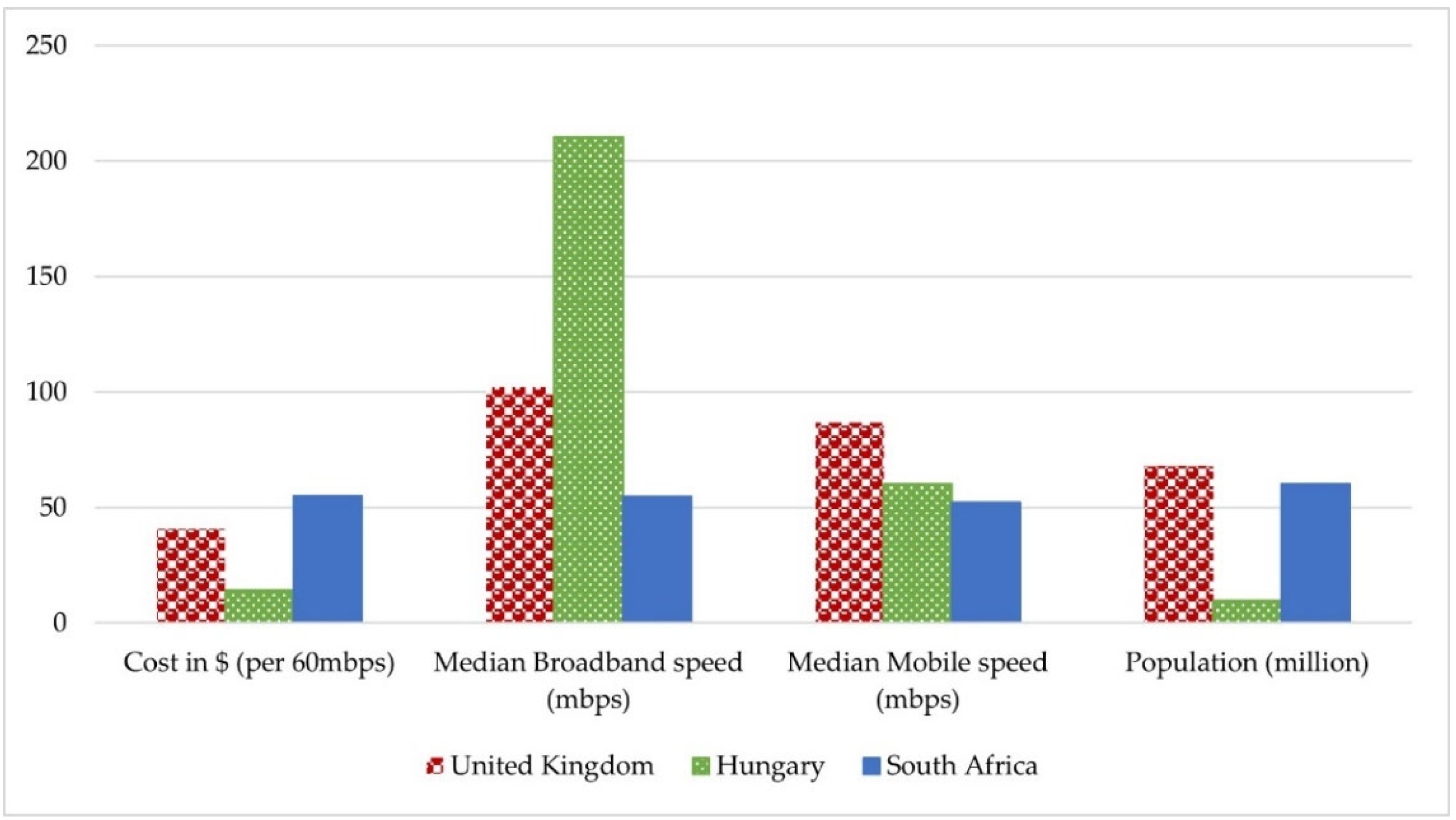Your browser does not fully support modern features. Please upgrade for a smoother experience.

Submitted Successfully!
Thank you for your contribution! You can also upload a video entry or images related to this topic.
For video creation, please contact our Academic Video Service.
| Version | Summary | Created by | Modification | Content Size | Created at | Operation |
|---|---|---|---|---|---|---|
| 1 | Andrea Tick | -- | 2488 | 2022-10-06 09:21:59 | | | |
| 2 | Amina Yu | -2 word(s) | 2486 | 2022-10-08 05:40:45 | | |
Video Upload Options
We provide professional Academic Video Service to translate complex research into visually appealing presentations. Would you like to try it?
Cite
If you have any further questions, please contact Encyclopedia Editorial Office.
Venter, I.M.; Cranfield, D.J.; Tick, A.; Blignaut, R.J.; Renaud, K.V. Digital and Emergency eLearning Technologies during COVID-19 Lockdown. Encyclopedia. Available online: https://encyclopedia.pub/entry/28308 (accessed on 08 January 2026).
Venter IM, Cranfield DJ, Tick A, Blignaut RJ, Renaud KV. Digital and Emergency eLearning Technologies during COVID-19 Lockdown. Encyclopedia. Available at: https://encyclopedia.pub/entry/28308. Accessed January 08, 2026.
Venter, Isabella M., Desirée J. Cranfield, Andrea Tick, Renette J. Blignaut, Karen V. Renaud. "Digital and Emergency eLearning Technologies during COVID-19 Lockdown" Encyclopedia, https://encyclopedia.pub/entry/28308 (accessed January 08, 2026).
Venter, I.M., Cranfield, D.J., Tick, A., Blignaut, R.J., & Renaud, K.V. (2022, October 06). Digital and Emergency eLearning Technologies during COVID-19 Lockdown. In Encyclopedia. https://encyclopedia.pub/entry/28308
Venter, Isabella M., et al. "Digital and Emergency eLearning Technologies during COVID-19 Lockdown." Encyclopedia. Web. 06 October, 2022.
Copy Citation
The pandemic disrupted all aspects of citizens’ lives—health services, the economy and educational practices. Government-mandated social distancing and stay-at-home injunctions required a drastic change in educational processes and delivery. The digital economy became the glue holding the “socially-distanced economy” together. As Bhaskar et al. (p. 6) contended, digitalization helped people to work, learn, shop, and socialize while locked down; it allowed society to cling to some semblance of normalcy.
COVID-19
higher education
student learning
digital technologies
digital trust
digital access
online learning
1. Introduction
It has become imperative for higher education institutions to understand the pandemic-related challenges and experiences of their students: i.e., how did the sudden shift to online learning impact them? Such insights can inform policy makers, education managers and academics and help them to plan for future disruptions to normal practice.
The sudden shift to remote learning and tuition placed a huge burden on both educators and learners [1] with both being unprepared for the shift [2]. Both, in many instances, were confronted with technologies that had to be mastered in a very short period to prepare and deliver/consume online content. Moreover, new ways of working and communicating between students and educators had to emerge, which impacted students’ learning experiences, and possibly their satisfaction and well-being. Furthermore, new assessment strategies had to be adopted to be more conducive to online assessment to prevent irregular and unethical behaviours—such as cheating during online examinations [3]; this was a transition from traditional face-to-face or blended approaches to a purely digital mode of tuition: i.e. eLearning. Khalid et al. [4] suggest several criteria (see Figure 1) to be considered for eLearning readiness; these are: content, equipment (upgrading and maintenance), psychology (attitudes), sociology (relationships), technology (connectivity), physical environment (home), financial (ability and costs to access the Internet) and human resources (for training and support). However, there was too little time for universities to satisfy these criteria, especially in traditional universities where teaching is usually delivered face-to-face.
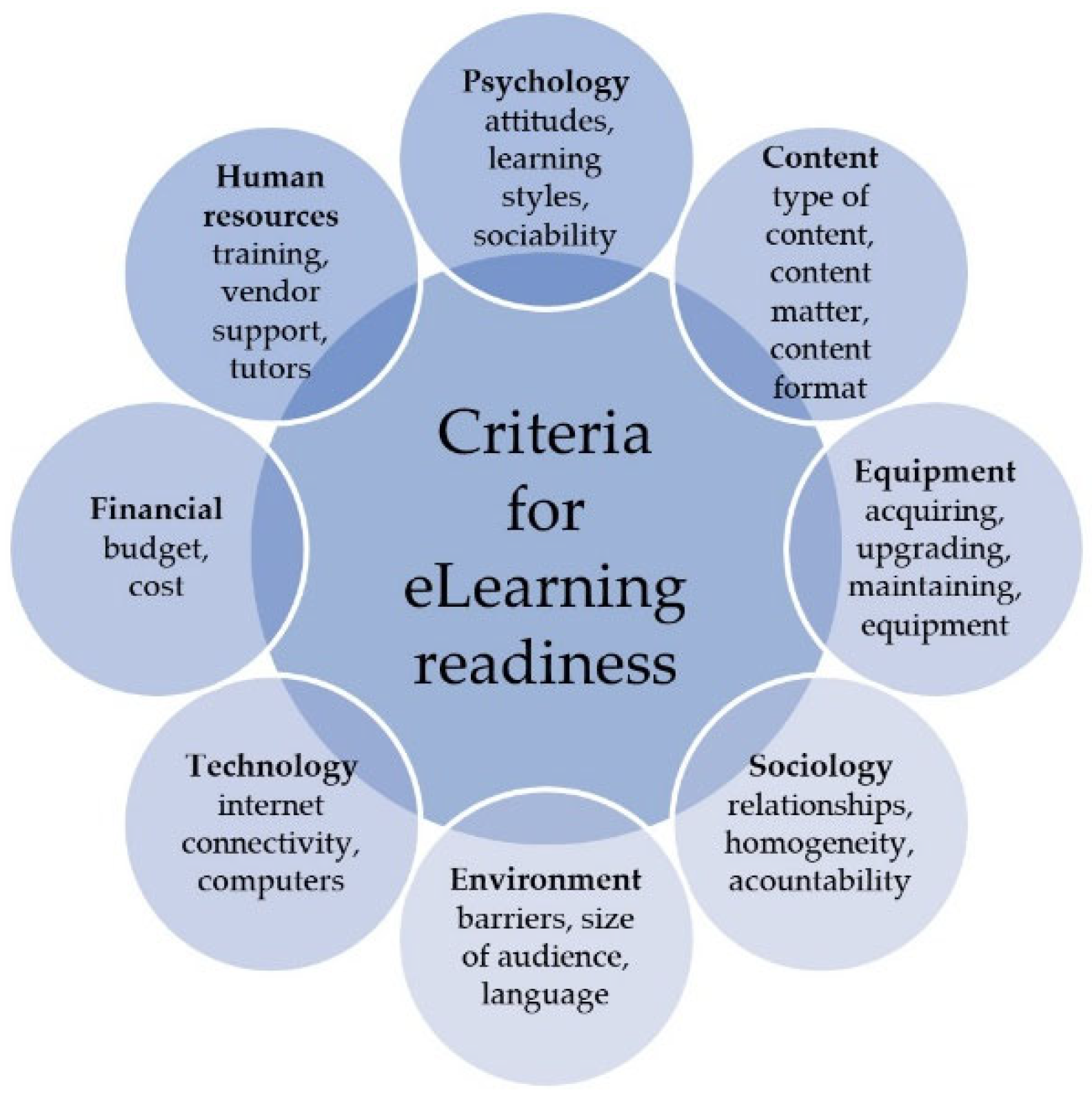
Figure 1. Criteria for eLearning readiness—adapted from Khalid, Jahan and Sobhan [4].
For many students, it was difficult to switch to home learning. Challenges could often be linked to socio-economic status, living space and the number of people cohabiting with them. To access online learning environments, a computer (rather than a smartphone) with Internet access is required. However, according to Van Lancker and Parolin [5], this is not even available to all first-world citizens, since five percent of European learners are living in conditions without a decent place to do homework and seven percent have no access to the Internet [5]. In Hungary, the majority of students have broadband Internet access [6]. Students who rely on part-or full-time work may not have been able to continue earning during the pandemic, which could have impacted their economic situation [1]. In South Africa, access to the Internet is mostly via mobile phone and data costs render access economically infeasible for many [7], which is confirmed by Woltran et al. [8].
The global impact of the COVID-19 pandemic, as well as the path of countries’ post-pandemic recovery, is yet to be scoped; it is quite possible that the best practices that have emerged since 2020 can feed into future best practices. As we emerge from the COVID-19 pandemic, it is imperative for Higher Education Institutions (HEIs) to understand the challenges that students faced, and still face, and to explore their experiences of remote learning. Measures should be put in place to ensure good student outcomes and engender positive student learning experiences post-pandemic; it is also important to determine how to deal with the consequences of the shift to online learning on 2020–2021 cohorts’ academic careers.
It was found that the emergency eLearning and the pandemic required academic staff to revolutionize their teaching methods to include innovative practices, to accommodate students demands. Higher education institutions need to be prepared to transform their educational practices. Additionally, the timing of the development of digital skills was found to be important, the earlier it is introduced into the curriculum, the more beneficial for the student experience.
2. Related Terms and Theories Used
To enhance the clarity of the discussion, some definitions are provided:
Digital access is the physical ability to gain access to the Internet; it encompasses the digital learning environment—namely, location, devices, ownership, and affordability [9].
The digital divide, or technology gap, refers to the difference between those with, and those without, access to the Internet and related technologies [9].
Bhaskar et al. [10] (p. 25) define the term digital trust as “…the confidence that causes users to exercise a choice to interact, transact, and consume online. Fundamentally, it determines the quality of the interaction between those who give trust and those who guarantee to uphold said trust”. Bhaskar et al. delineate four drivers of digital trust:
-
Environment—How to build trust in the digital environment?
-
Experience—How is the digital trust environment provided by the guarantors of institutions and governments experienced?
-
Attitudes—Do users trust the digital trust environment?
-
Behaviour—Are consumers engaged in the digital environment?
Herein, digital trust includes attitudes—towards their Internet access, quality of access and system functionality—and behaviours—focusing on their approach to collaborative tools, their Learning Management System (LMS), the transition to e-Learning, digital tools used, and digital features (see Figure 2).

Figure 2. Research questions in relation to digital trust and digital access.
2.1. The Digital Development of Participating Countries
The universities in each of the three countries—South Africa, United Kingdom (Wales), Hungary—are not homogenous entities; their students come from diverse cultures, backgrounds, and countries of birth. Yet, as groups of residential students, they were equally impacted by the ways in which their universities supported them during this period—for example, in South Africa, students were provided with laptops and data to access online learning material. The way the country’s government supported the university during the transition to online learning was also relevant; it is important to describe the context of each country’s digital technology development, given the focus on digital access, attitudes and the behaviours of students (as described in the construct in (Figure 2). Several research studies have been conducted to better understand and measure country-specific stances on information and communications technology use, capacity, and readiness. In addition, several frameworks have been developed that measure the digital intelligence and readiness of countries. The next section introduces two of these frameworks.
2.1.1. Digital Intelligence Index (DII) of Participating Countries
The Digital Intelligence Index (DII) considers several criteria (Digital Evolution, Digital Trust, Remote Work Readiness, New GDP, AI readiness). The first two measures are pertinent here.
Digital Evolution tracks the rate of digitalization of 90 economies—comprising 95% of the world’s online population—from 2008 to 2019; this DII measure provides business and policy guidance for digital growth [10]. The DII is represented as a function of two factors: (1) its current state of digitalization (state), and (2) its pace of digitalization over time (momentum) [10]. The digital trajectory of higher education can also be considered a function of these two factors. Countries are segmented into four quadrants, namely ‘Stand Out’, ‘Break Out’, ‘Stall Out’, and ‘Watch Out’ economies [11]. The DII places the United Kingdom in the ‘Stall Out’ quadrant, which represents a high state of digital advancement while slowing down. Hungary and South Africa are placed in the ‘Watch Out’ quadrant, both facing significant challenges with their low state of digitalization, and slow development. None of these universities are in the ‘Stand Out’ or ‘Break Out’ quadrants. The ‘Stand Out’ quadrant suggests a digitally advanced economy with high momentum (top right), while the ‘Break Out’ quadrant represents economies that exhibit a current state of low digitalization but are evolving rapidly. Figure 3 captures how digitalization or digital evolution varies in economies across the three participating universities.
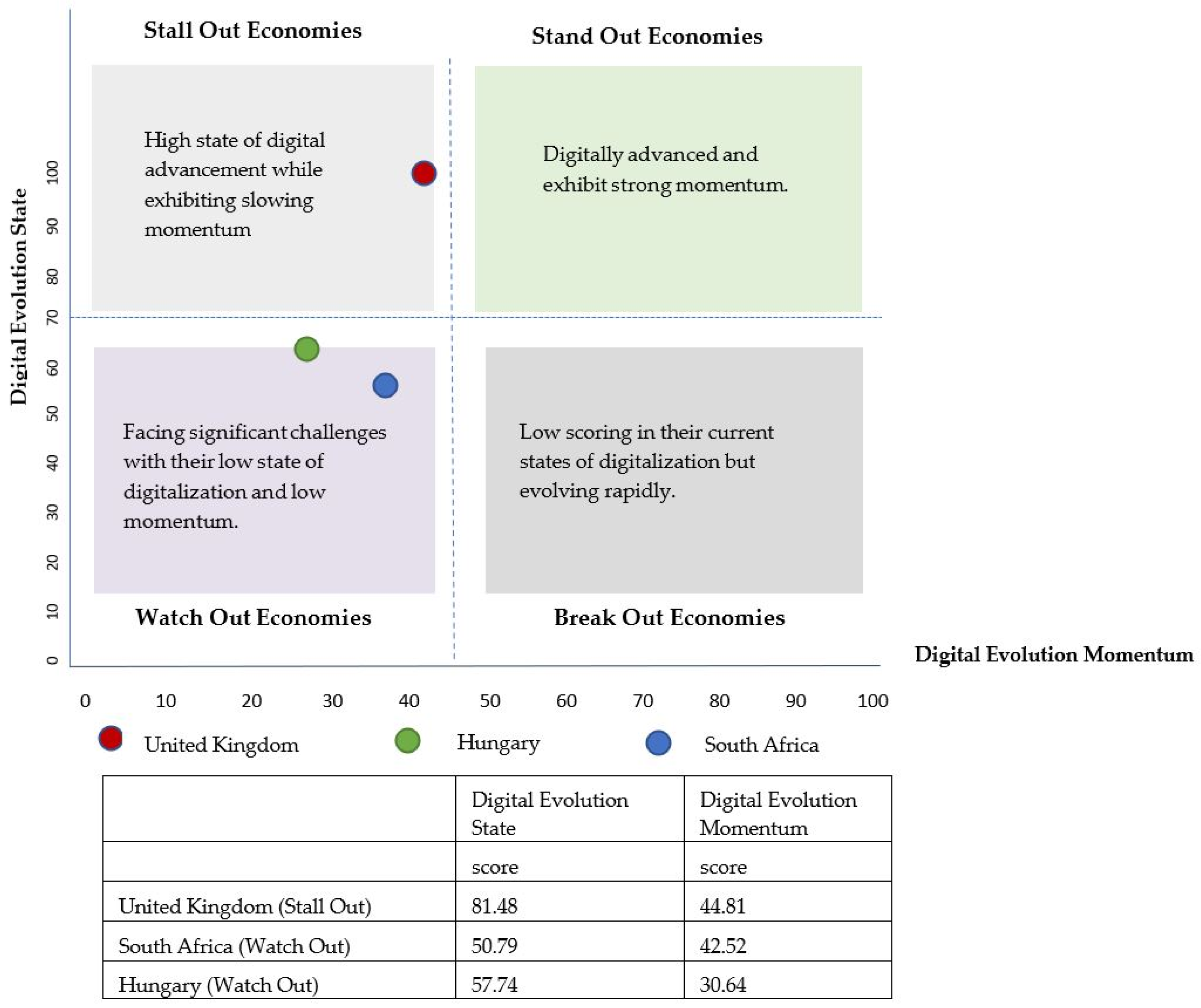
Figure 3. The Digital Intelligence Index by country—United Kingdom, South Africa, Hungary-adapted from Bhaskar, Chaturvedi, Filipovic and Brewer [10].
2.1.2. The Network Readiness Index
The Network Readiness Index (NRI) was launched in 2000, and considered 50 high-income economies, 35 upper-middle countries, 34 lower-middle income countries, and 15 low-income countries: a total of 134 economies were considered. The index included countries from all continents [12], and offers a balance between the technology and human dimensions of network readiness, emphasizing the importance of measuring trust, security, privacy, and the abilities to leverage technological change to address global challenges. These include climate change, and thereby accelerate the realization of the related Sustainable Development Goals (SDGs) as set out by the United Nations (https://sdgs.un.org/#goal_section, accessed on 19 January 2022) see Figure 4.
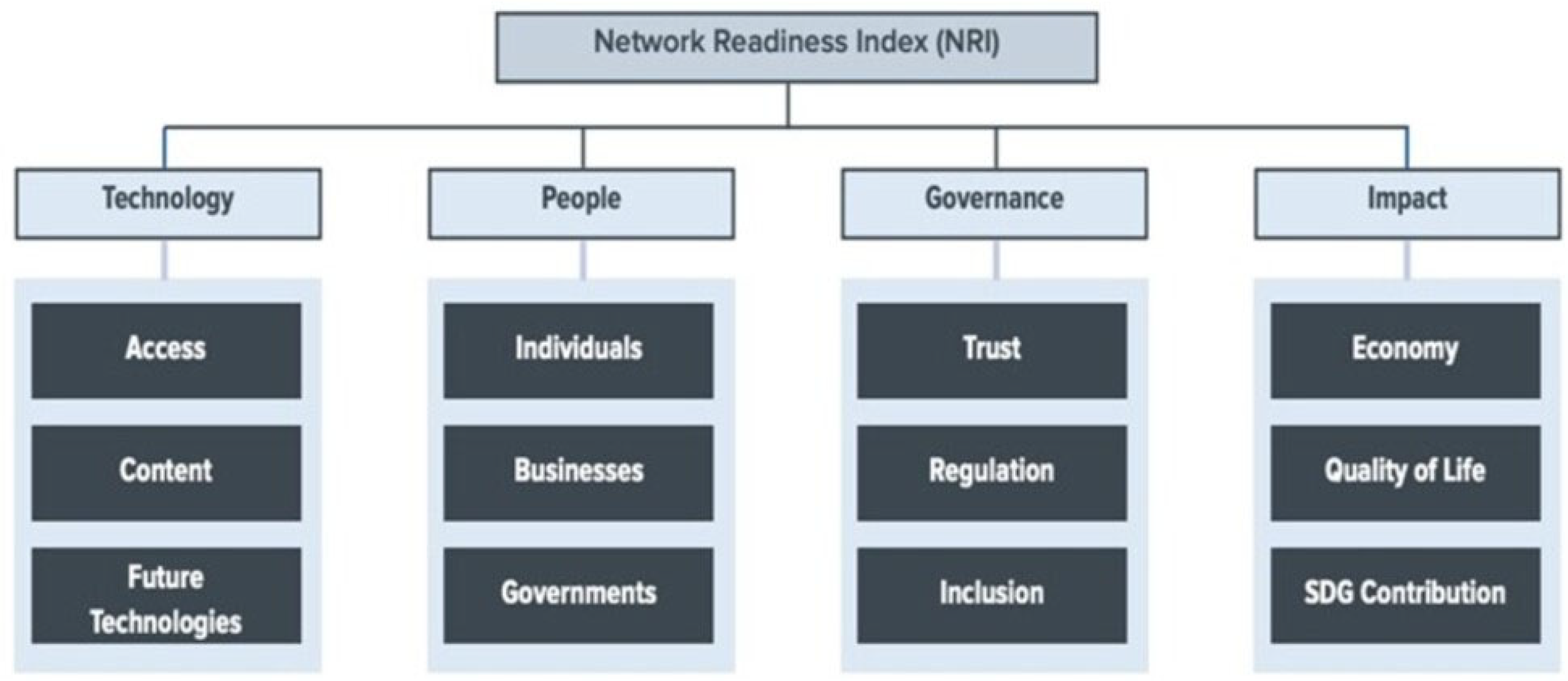
Figure 4. The Network Readiness Index [12] (p. 31).
This index focuses on four dimensions, namely Technology, People, Governance, and Impact. Technology measures the access to communications infrastructure and affordability; both in terms of local content and applications and a country’s preparedness to adopt future technologies. The People dimension examines individuals, businesses, and governments, namely how they use technology, and how they leverage their skills to participate in the economy. In the Governance dimension, pillars such as trust (trust behaviour), regulations (promoting participation), and inclusion (digital divide addressed), are considered, all being central to successful digital transformation. The fourth dimension, Impact on economy (the economic impact of participating), includes the quality of life (social impact of participating), and sustainability i.e., SDG contribution, participating in the sustainable development goals set by the United Nations.
Each of the countries was given a Network Readiness Ranking Index score for each of the four dimensions, as can be seen in Figure 5. Hungary and the United Kingdom have similar rankings for each of their individual dimensions, but South Africa shows quite a difference in its individual ranking for each dimension.
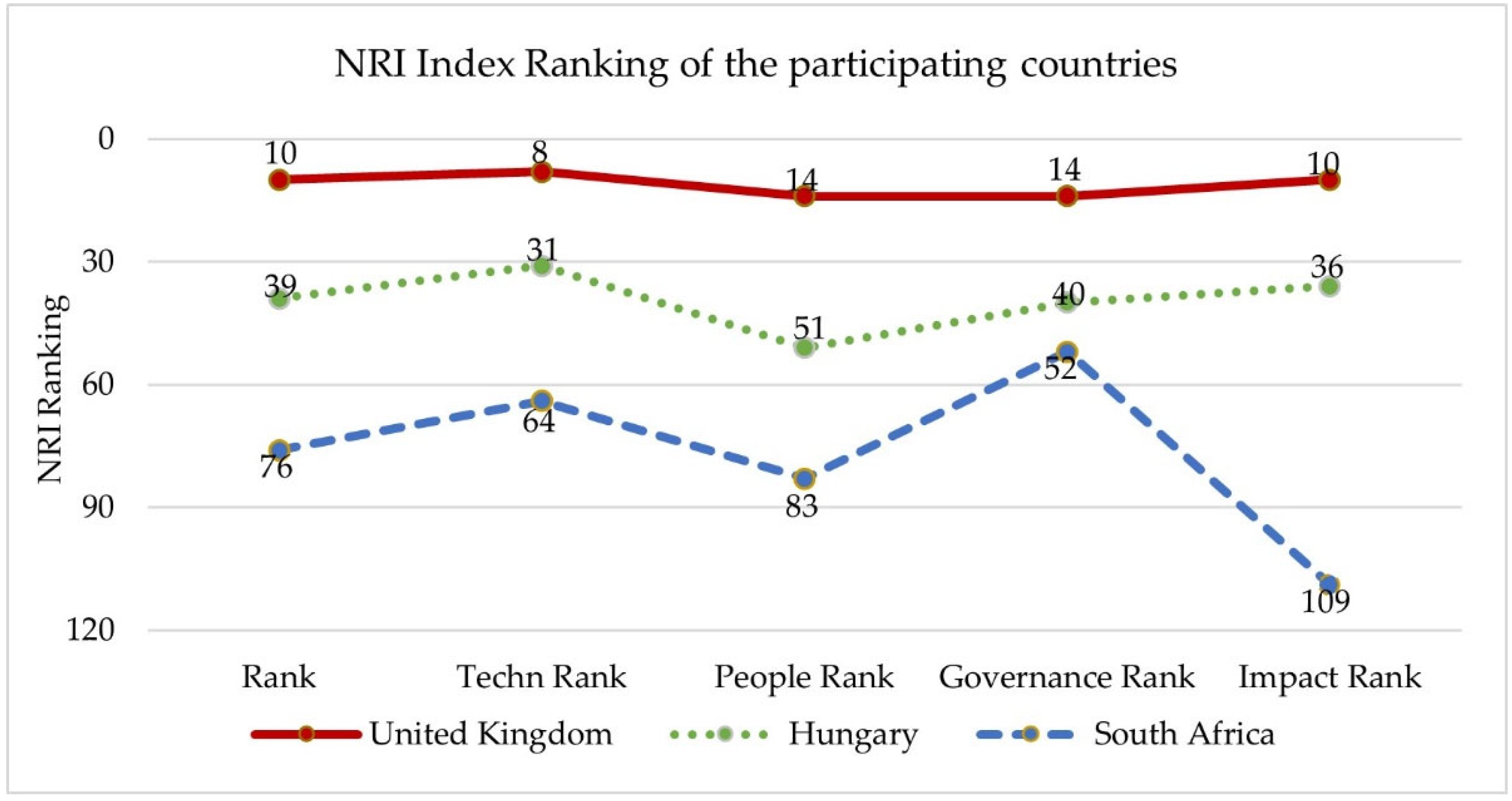
Figure 5. Network Readiness Index rankings of Hungary, South Africa, and the United Kingdom by dimension [12].
It is also important to understand the participating countries’ economic development, which impacts each country’s readiness for digital transformation. Figure 6 presents each participating country’s Network Readiness in relation to its economic development (Gross Domestic Product (GDP) per capita). South Africa belongs to the ‘upper-middle income’ group, while Hungary and the United Kingdom (Wales) are considered ‘high income’ countries.
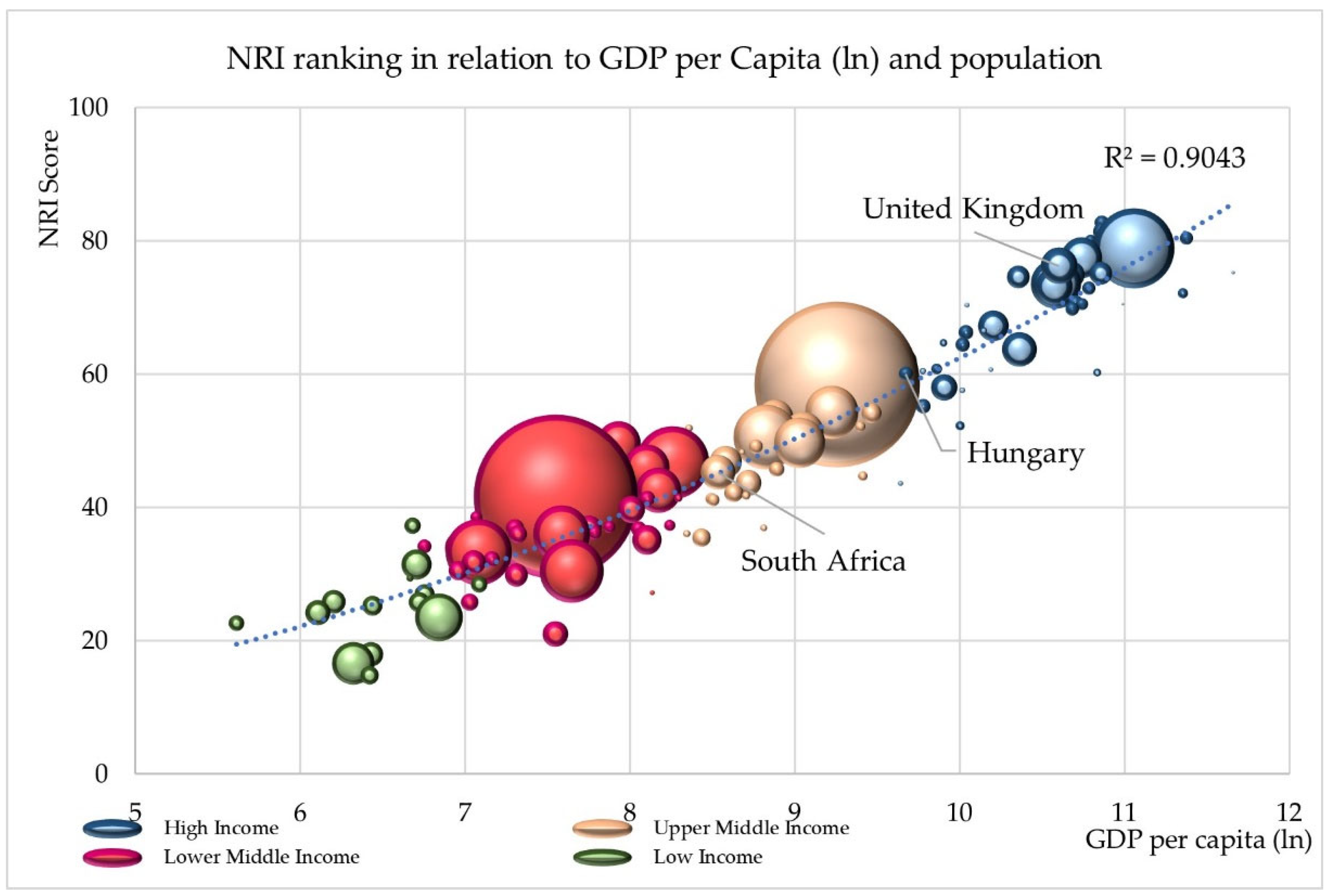
Figure 6. The three participating countries position by NRI based on GDP per capita (Source: developed from data from [12]).
2.2. Participating Countries’ Digital Access
This section focuses on the number of households with Internet access at home, the speed and cost of accessing the Internet, and the average download speed. Each of these factors has an impact on students’ learning experience in terms of studying at each participating university within the relevant country.
2.2.1. Households Having Internet Access at Home
Figure 7 provides a snapshot (2019 and 2020) of the percentage of households having Internet access in South Africa, the United Kingdom and Hungary [13]. The number of households in South Africa who have Internet access is substantially lower (63%) than for households in Hungary (88%) and the United Kingdom (95%); this would have a direct impact on the ability of students to access digital learning education materials from home, creating a particular challenge for South African students.
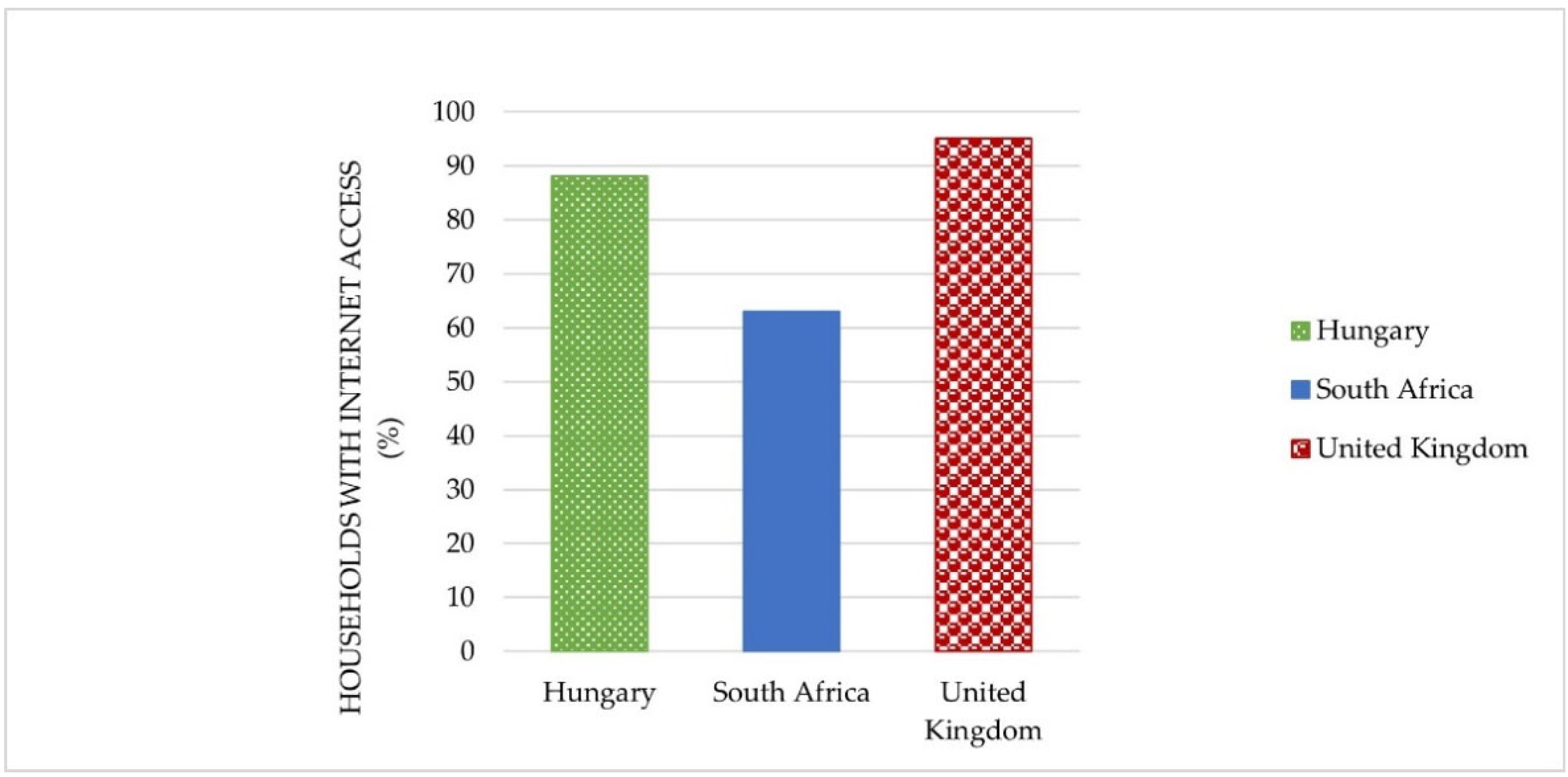
Figure 7. Households with Internet access at home (%) [13].
2.2.2. Internet Speed and Cost
When considering the populations of the countries, it should be noted that the population of the UK and South Africa is similar, whereas Hungary’s population is considerably smaller. Furthermore, South Africa is a larger country geographically, as compared to Hungary and the UK (thirteen times larger than Hungary and 5 times larger than the UK). The population size and physical distances might impact the costs of broadband and mobile Internet; it is interesting to note that Hungary’s broadband speed is notably faster than that of the UK, and the speed in South Africa is even slower (see Figure 8) but costs are considerably lower than in both South Africa and the UK, with South Africa paying the most [14].
2.3. Theoretical Underpinnings
Structuration, postmodernism, and critical social theory were used as lenses to understand the student experience of the participating students engaging in online learning during the first wave of the pandemic; these lenses will be described in this section.
2.3.1. Postmodernism
The society we live in has radically changed—“our world is now a world of postmodernity” [16] (p. 191); it is important to make a distinction between postmodernity and postmodernism. Postmodernity can be defined as a “distinctive historical period in the development of society” whereas postmodernism considers a “qualitative” new society, that is, it signals the transformation of the concept of art—social science, modern art, philosophy, music and literature—and its relationship to other social practices. Postmodernity can thus be seen as postmodernism at a moment of time and represents a different way of thinking and communicating.
2.3.2. Critical Social Theory
Critical social theory, a neo-humanist approach, which considers how to improve the human condition [17]. Hence, its aim is an all-encompassing approach to active participation, observation and analysis of the situation and the design of an intervention to accomplish change. According to Habermas [17], “content” and “relationship” are two criteria that can be used to analyse and validate discussion about research.
Ngwenyama [18] (p. 269) is of the opinion that critical social theory is based on five assumptions, namely:
-
The social world is created by humans and can thus be changed if they so desire.
-
Scientific knowledge is value-laden, more specifically when considering the social world.
-
Reason and critique are two sides of a coin. Reason allows for the understanding of the social world, and to critique, it allows the search for alternatives. Reason and critique can, therefore, not be separated.
-
Critical social theory creates the environment for the reconciliation of ‘knowledge’ with ‘the human need for self-improvement’ and, as such, theory and praxis are interconnected.
-
Finally, those affected by research should be allowed to collaborate with the researchers for the research to be open to public debate.
2.3.3. Structuration
Giddens [19] contends that structuration is a ‘social theory’ that scrutinizes both structure and agents, without valuing the one above the other. Information technology has transformed modern society with its globalizing tendencies and the consequential reorganization of social structures.
According to Giddens [20], time and space impact social practices. The separation of time and space ‘removes’ the local context of the interaction. In our era, ‘late modernity’, social interaction is continuously revised, see Figure 9, where interaction between structure and agency can lead to changed preferences and perceived ease of use [21]. Giddens [19] suggests that structuration purports the duality of structure, which includes rules (how things are done) and resources (how things can help get things done). Each person’s rules are developed by three elements, significance—how an event is interpreted, legitimization—what should happen in a situation, and domination-what means should be used to accomplish goals [22]. Each student would therefore have a combination of these elements. Panigraphi et al. [23] (p. 1843) suggest that individuals have the capacity to reflect on their behaviour and make changes where required and when engaging with structures.

Figure 9. Interaction between structure and agent, leads to change, adapted from [24].
The global burden of the pandemic has catapulted society into embracing these new practices and organizations and society has needed to rely on and transform digitally, reaching a new level of ‘digital maturity’.
References
- Grant, K.; Gedeon, S. The Impact of COVID-19 on University Teaching. In The University of the Future-Responding to COVID-19; Reading, ACPIL: London, UK, 2020; p. 161.
- Tick, A.; Cranfield, D.J.; Venter, I.M.; Renaud, K.V.; Blignaut, R.J. Comparing Three Countries’ Higher Education Students’ Cyber Related Perceptions and Behaviours during COVID-19. Electronics 2021, 10, 2865.
- Singh, S. Reflecting on Higher Education Examinations. In The University of the Future: Responding to COVID-19; Reading, ACIL: Delhi, India, 2020; p. 161.
- Khalid, M.S.; Jahan, A.; Sobhan, M.A. E-Preparedness of Students of Private Universities in Bangladesh for Blended E-Learning: A Case Study. In Proceedings of the World Congress on ICT for Development, WCID’09, Beijing, China, 2–4 September 2009.
- Van Lancker, W.; Parolin, Z. COVID-19, school closures, and child poverty: A social crisis in the making. Lancet Public Health 2020, 5, e243–e244.
- Tick, A. IT Security as a Special Awareness at the Analysis of the Digital/E-learning Acceptance Strategies of the Early Z Generation. In Proceedings of the 22nd International Conference on Intelligent Engineering Systems (INES), Las Palmas, Spain, 21–13 June 2018.
- Venter, I.; Daniels, A. Towards bridging the digital divide: The complexities of the South African story. In Proceedings of the 14th Annual International Technology, Education and Development Conference INTED2020, Valencia, Spain, 2–4 March 2020; pp. 3250–3256.
- Woltran, F.; Lindne, K.-T.; Dzojic, T.; Schwab, S. Will–Skill–Tool Components as Key Factors for Digital Media Implementation in Education: Austrian Teachers’ Experiences with Digital Forms of Instruction during the COVID-19 Pandemic. Electronics 2022, 11, 1805.
- Van Dyk, J.A. Digital Divide: Impact of Access. In The International Encyclopedia of Media Effects; Rössler, P., Hoffner, C.A., van Zoonen, L., Eds.; University Twente: Enschede, The Netherlands, 2017; pp. 1–11.
- Bhaskar, C.; Chaturvedi, R.S.; Filipovic, C.; Brewer, G. Digital Intelligence Index, The Fletcher School, Medford. 2021. Available online: https://sites.tufts.edu/digitalplanet/files/2021/01/Digital-Planet-Dispatch-January-2021.pdf (accessed on 24 May 2021).
- The Fletcher School Tufts University, Digital Intelligence Index. December 2021. Available online: https://digitalintelligence.fletcher.tufts.edu/trajectory (accessed on 2 January 2022).
- Portulans Institute. The Network Readiness Index 2020 and Accelerating Digital Transformation in a Post-COVID Global Economy; Portulans Institute: Washington, DC, USA, 2021; Available online: https://networkreadinessindex.org/wp-content/uploads/reports/nri_2021.pdf (accessed on 2 February 2022).
- ITU Secretariat. ICT Development Index 2020: A Proposal; ITU Secretariat: Geneva, Switzerland, 2020; Available online: https://www.itu.int/en/ITU-D/Statistics/Documents/events/egti2020/IDI2020_BackgroundDocument_20200903.pdf (accessed on 20 October 2021).
- Speedtest Global Index, Internet Speeds by Country 2021. Available online: https://worldpopulationreview.com/country-rankings/internet-speeds-by-country (accessed on 17 November 2021).
- Numbeo, Price Rankings by Country of Internet (60 Mbps or More, Unlimited Data, Cable/ADSL) (Utilities (Monthly)). 2021. Available online: https://www.numbeo.com/cost-of-living/country_price_rankings?itemId=33 (accessed on 13 December 2021).
- Crotty, M. The Foundations of Social Research: Meaning and Perspective in the Research Process, 3rd ed.; SAGE Publications: St Leonards, Australia, 1998.
- Habermas, J. Theorie des Kommunikativen Handels: Band I, Handlungsrationalität und Gesellschaftliche Rationalisierung; Suhrkamp Verlag: Frankfurt am Main, Germany, 1981.
- Ngwenyama, O.K. The critical social theory approach to information systems: Problems and challenges. In Information Systems Research; Elsevier Science Publishers B.V.: Amsterdam, The Netherlands, 1991; pp. 267–279.
- Giddens, A. The Constitution of Society: Outline of the Theory of Structuration; Cambridge Polity Press: Cambridge, UK, 1984.
- Giddens, A. The Consequences of Modernity; Stanford University Press: Stanford, CA, USA, 1990.
- Poole, M. Adaptive Structuration Theory. In A First Look at Communication Theory; McGraw Hill: Washington, DC, USA, 2006; pp. 235–246. Available online: https://psycnet.apa.org/record/2005-12493-000 (accessed on 25 November 2021).
- Walden, M. COMS-520 Structuration Theory, Traub, M., Lynchburg. 2016. Available online: https://www.youtube.com/watch?v=Mx7M2CdUyIM (accessed on 10 January 2022).
- Panigraphi, R.; Srivastava, P.R.; Panigraphi, P.K. Effectiveness of e-learning: The mediating role of student engagement on perceived learning effectiveness. Inf. Technol. People 2021, 34, 1840–1862.
- Tiefenbacher, W. Structuration Theory and Its Implications for Management: Key Take-Aways for Managers and Working Professionals. 2 January 2020. Available online: https://www.ckju.net/en/blog/structuration-theory-implication-management-take-aways-managers-professionals/28581 (accessed on 19 January 2022).
More
Information
Subjects:
Education & Educational Research
Contributors
MDPI registered users' name will be linked to their SciProfiles pages. To register with us, please refer to https://encyclopedia.pub/register
:
View Times:
1.2K
Entry Collection:
COVID-19
Revisions:
2 times
(View History)
Update Date:
13 Oct 2022
Notice
You are not a member of the advisory board for this topic. If you want to update advisory board member profile, please contact office@encyclopedia.pub.
OK
Confirm
Only members of the Encyclopedia advisory board for this topic are allowed to note entries. Would you like to become an advisory board member of the Encyclopedia?
Yes
No
${ textCharacter }/${ maxCharacter }
Submit
Cancel
Back
Comments
${ item }
|
More
No more~
There is no comment~
${ textCharacter }/${ maxCharacter }
Submit
Cancel
${ selectedItem.replyTextCharacter }/${ selectedItem.replyMaxCharacter }
Submit
Cancel
Confirm
Are you sure to Delete?
Yes
No


